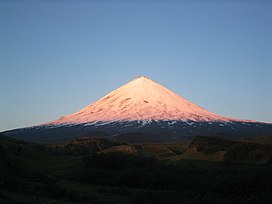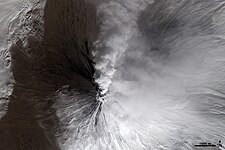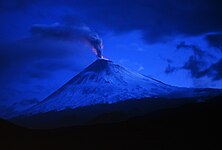geo.wikisort.org - Mountains
Klyuchevskaya Sopka (Russian: Ключевская сопка; also known as Klyuchevskoi, Russian: Ключевской) is a stratovolcano, the highest mountain of Siberia and the highest active volcano of Eurasia. Its steep, symmetrical cone towers about 100 kilometres (60 mi) from the Bering Sea. The volcano is part of the natural Volcanoes of Kamchatka UNESCO World Heritage Site.
| Klyuchevskaya Sopka | |
|---|---|
 Klyuchevskaya Sopka in January 2007 | |
| Highest point | |
| Elevation | 4,754 m (15,597 ft) |
| Prominence | 4,649 m (15,253 ft) Ranked 13th |
| Isolation | 2,748 km (1,708 mi) |
| Listing | Ultra |
| Coordinates | 56°03′22″N 160°38′39″E |
| Geography | |
 Klyuchevskaya Sopka Location in Kamchatka Krai, Russia | |
| Location | Kamchatka, Russia |
| Parent range | Eastern Range |
| Geology | |
| Mountain type | Stratovolcano (active) |
| Last eruption | 2021 |
| Climbing | |
| First ascent | 1788 by Daniel Gauss and 2 others |
| Easiest route | basic rock/snow climb |
 | |
Klyuchevskaya appeared 6,000 years ago.[1] Its first recorded eruption occurred in 1697,[1] and it has been almost continuously active ever since, as have many of its neighboring volcanoes. It was first climbed in 1788 by Daniel Gauss and two other members of the Billings Expedition.[2] No other ascents were recorded until 1931, when several climbers were killed by flying lava on the descent. As similar dangers still exist today, few ascents are made.
Klyuchevskaya Sopka is considered sacred by some indigenous peoples, being viewed by them as the location at which the world was created.[citation needed] Other volcanoes in the region are seen with similar spiritual significance, but Klyuchevskaya Sopka is the most sacred of these.
Eruptions
Klyuchevskaya volcano has erupted 110 times during the Holocene Epoch.[1]
2007 eruption
Beginning in early January 2007, the Klyuchevskaya volcano began another eruption cycle. Students from the University of Alaska Fairbanks and scientists of the Alaska Volcano Observatory traveled to Kamchatka in the spring to monitor the eruption. On 28 June 2007, the volcano began to experience the largest explosions so far recorded in this eruption cycle. An ash plume from the eruption reached a height of 10 km (33,000 ft) before drifting eastward, disrupting air traffic from the United States to Asia and causing ashfalls on Alaska's Unimak Island.[citation needed]
2010 eruption
As early as 27 February 2010, gas plumes had erupted from Klyuchevskaya Sopka (reaching elevations of 7,000 m (22,966 ft)) and during the first week of March 2010, both explosive ash eruptions and effusive lava eruptions occurred until, by 9 March, the ash cloud was reported to have reached an elevation of 6,000 m (19,685 ft). Also, significant thermal anomalies have been reported and gas-steam plumes extended roughly 50 km (31 mi) to the north-east from the volcano on 3 March.[citation needed]
2012 eruptions
On 15 October 2012, the volcano had a weak eruption that stopped the following day. Also a weak thermal eruption occurred on 29 November 2012, then stopped again, as all of its neighboring volcanoes Bezymianny, Karymsky, Kizimen, Shiveluch, and Tolbachik erupted more actively and continuously, taking a major magma supply load off of Klyuchevskaya Sopka.[citation needed]
2013 eruptions
On 25 January 2013, the volcano had a weak Strombolian eruption that stopped the following day. During January 2013, all volcanoes in the eastern part of Kamchatka —Bezymianny, Karymsky, Kizimen, Klyuchevskaya Sopka, Shiveluch, and Tolbachik erupted, with the exception of Kamen.[citation needed]

On 15 August 2013, the volcano had another weak Strombolian eruption with some slight lava flow that put on an excellent fireworks display before stopping on 21 August 2013, when Gorely Volcano woke up and started erupting again in relief of Klyuchevskaya Sopka.[citation needed]
On 12 October, Klyuchevskaya had another three days of on-and-off eruptions with anomalies and a short ash plume, possibly indicating Strombolian and weak Vulcanian activity. An explosion from a new cinder cone low on Kliuchevskoi's southwest flank occurred on 12 October. An ash plume rose to altitudes of 6–7 km (20,000–23,000 ft), and drifted eastward. The eruptions weakened and paused by 16 October 2013.[3]
On 19 November, a strong explosion occurred, and observers reported that ash plumes rose to altitudes of 10–12 km (33,000–39,000 ft) and drifted southeast. The Aviation Color Code was raised to Red. Later that day, the altitudes of the ash plumes were lower and the eruptions weakened and stopped again.[citation needed]
On 7 December, activity at Kliuchevskoi significantly increased, having continued during 29 November – 7 December, prompting KVERT to raise the Alert Level to Red. Ash plumes rose to altitudes of 5.5–6 km (18,000–20,000 ft) above sea level and drifted more than 212 km (132 mi) northeast and over 1,000 km (621 mi) east. According to a news article, a warning to aircraft was issued for the area around the volcanoes. Video showed gas-and-steam activity, and satellite images detected a daily weak thermal anomaly. On 9 December, the Alert Level was lowered to Green when the eruptions abruptly stopped.[citation needed]
2015 eruptions
On 2 January 2015, after a one-year period of inactivity, the volcano had a Strombolian eruption which stopped on 16 January 2015. Minor eruptions resumed on 10 March 2015 and stopped on 24 March 2015. On 27 August 2015, the volcano had another Strombolian eruption which ended 16 hours later.[citation needed]
2019 eruptions
Kluchevskaya Sopka saw renewed eruption activity beginning in 2019.[4] On 25 October 2019, the volcano had another weak Strombolian eruption which ended some 30 hours later.[citation needed]
2020 eruption
A volcanic eruption occurred on 9 December 2020.[citation needed]
2022 climbing accidents
In September 2022, nine people died while climbing Kluchevskaya Sopka. They were part of a 12-strong group of Russian nationals, which included two guides. Five climbers were killed after a fall at about 4,000m. Another four, including a guide, died on the mountainside afterwards. A rescue helicopter managed to land at 1,663m at the fourth attempt, bringing rescuers who faced a two-day climb to reach a volcanologists' hut at 3,300m where the three survivors were sheltering.[5]
Images
- Klyuchevskaya Sopka in July 2006
- Space radar image over SRTM Elevation of Klyuchevskaya Sopka in October 1994.
- Satellite image of Klyuchevskaya Sopka in April 2010 by NASA.
- Satellite image and map of Klyuchevskaya Sopka in 2002 by NASA.
- The eruption of October 1994.
- The eruption of February 2005.
- The eruption of February 2010 taken by NASA ASTER.
- The eruption of March 2010.
- The eruption of November 16, 2013. Ushkovsky, Tolbachik, Zimina, Udina, and Bezymianny are also visible.
- Kluchevskaya Sopka
- Eruption of summer 1993
See also
- List of volcanoes in Russia
- Kronotsky Nature Reserve
- Valley of Geysers
- Kamchatka Peninsula
- Highest points of Russian Federal subjects
References
- "Klyuchevskoy: Eruptive History". Global Volcanism Program. Smithsonian Institution. Retrieved 2021-06-25.
- Dobkin, Josef (1989), "The Living Giants of Kamchatka", The American Alpine Journal, The American Alpine Club: 104, ISBN 0-930410-39-4
- "Global Volcanism Program | Report on Klyuchevskoy (Russia) — 16–22 October 2013". volcano.si.edu. Retrieved 2018-04-26.
- "Global Volcanism Program | Klyuchevskoy". Smithsonian Institution | Global Volcanism Program. Retrieved 2022-05-18.
- "Klyuchevskaya Sopka: Climbers killed during a fall on Russian volcano". BBC News. 2022-09-06. Retrieved 2022-09-10.
External links
- Klyuchevskaya Sopka (Climbing). on author's site sgan2009.ru "Russia begins here" (in Russian)
- "Klyuchevskoy". Global Volcanism Program. Smithsonian Institution. Retrieved 2008-12-18.
- Klyuchevskoy Volcano live webcam
- "Klyuchevskaya Sopka". Peakware.com. Archived from the original on 2016-03-04. – photos
- Science Daily article on the 2007 eruption's disruption of air traffic
На других языках
[de] Kljutschewskaja Sopka
Die Kljutschewskaja Sopka (russisch Ключевская сопка), auch Kljutschewskoi-Vulkan (russisch Ключевской Вулкан), auf der Halbinsel Kamtschatka in Russland ist der höchste aktive Vulkan Eurasiens und der höchste Berg Sibiriens im weiteren Sinne. Er ist etwa 8000 Jahre alt und zählt zum Pazifischen Feuerring. Er ist der höchste Vulkan der dicht beieinander stehenden zwölf Stratovulkane, welche die Kljutschewskaja-Gruppe bilden (auch nach den Namen der beiden Hauptvulkane als Kljutschewskoi-Besymjanny-Vulkankomplex bezeichnet). Zu ihr gehören z. B. auch der Kamen und der Ploski Tolbatschik.- [en] Klyuchevskaya Sopka
[es] Kliuchevskoi
El Kliuchevskói (en ruso, Ключевская сопка) es un estratovolcán basáltico situado cerca de la costa este de la península de Kamchatka, en Siberia Oriental, Rusia. El Kliuchevskói, simétrico y cubierto de nieve, es el más elevado y activo de una cadena de volcanes a lo largo de Kamchatka. Se formó hace unos 6000 años, y desde entonces ha producido frecuentes erupciones explosivas y efusivas, sin largos intervalos de inactividad. Más de 100 erupciones han producido, en los últimos 3000 años, numerosos conos y cráteres. Pero la mayoría de las erupciones se han originado en el cráter de la cima, de 700 metros de ancho, formado una y otra vez por las capas de materiales piroclásticos y las coladas de lava que expulsa.[fr] Klioutchevskoï
Le Klioutchevskoï (en russe : Ключевской Вулкан), aussi appelé Klioutchevskaïa Sopka (en russe : Ключевская сопка) est le plus haut sommet et le volcan le plus actif de la péninsule du Kamtchatka, en Russie[2]. Il est également le point culminant de la Sibérie[3], devançant le mont Béloukha (dans l'Altaï). C'est un stratovolcan basaltique[2] de 4 688 mètres[1] d'altitude né il y a environ 6 000 ans. Il fait partie de la ceinture de feu du Pacifique. Au large du Kamtchatka, une fosse océanique de 10 500 mètres de profondeur et des séismes témoignent de la subduction, à la vitesse de 10 cm/an, de la plaque pacifique sous la plaque eurasienne ; comme tous les volcans de la péninsule du Kamtchatka, le Klioutchevskoï est donc un volcan de subduction. Il a été classé, avec les autres volcans du Kamtchatka, au patrimoine mondial par l'UNESCO depuis 1996 (révisé en 2001).[it] Ključevskaja Sopka
La Ključevskaja Sopka (in russo: Ключевская сопка?) è uno stratovulcano dell'estremo oriente russo, compreso nella Catena Orientale nella penisola della Kamčatka.[ru] Ключевская Сопка
Ключевска́я Со́пка[2][3], или Ключевской[3][4] — действующий стратовулкан на востоке полуострова Камчатка. Самый высокий активный вулкан в Евразии. Возраст приблизительно 7000 лет[4][5].Другой контент может иметь иную лицензию. Перед использованием материалов сайта WikiSort.org внимательно изучите правила лицензирования конкретных элементов наполнения сайта.
WikiSort.org - проект по пересортировке и дополнению контента Википедии










